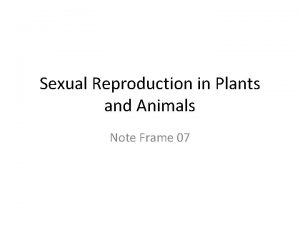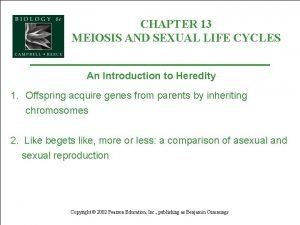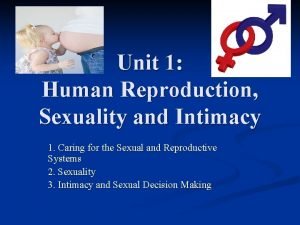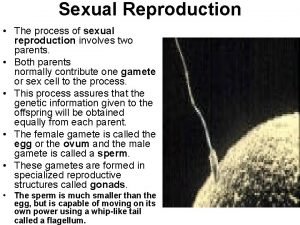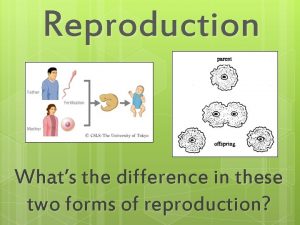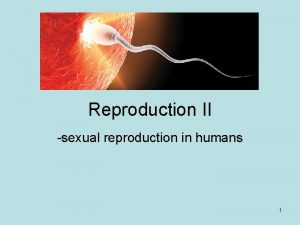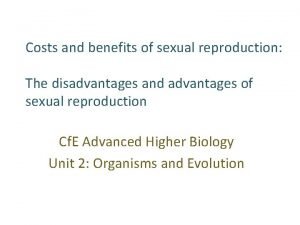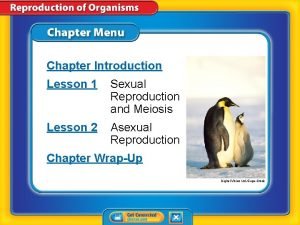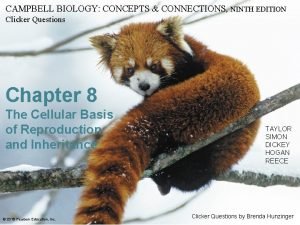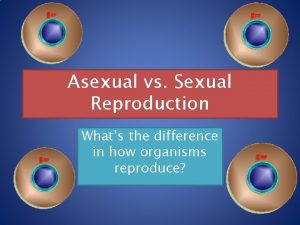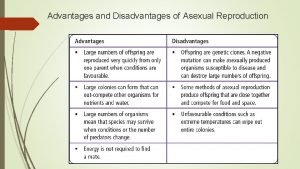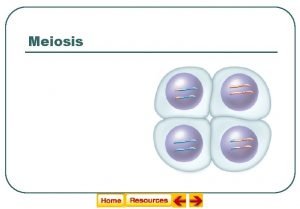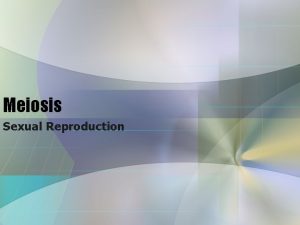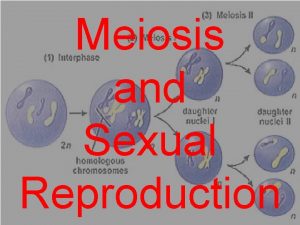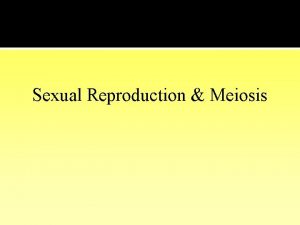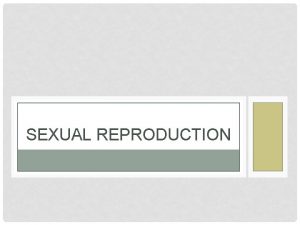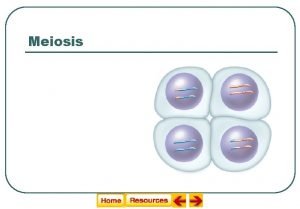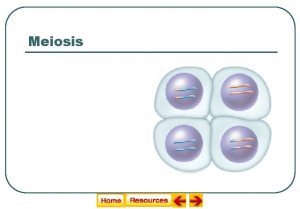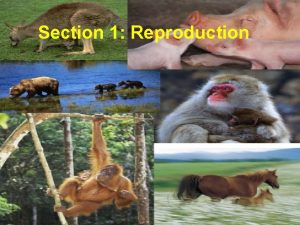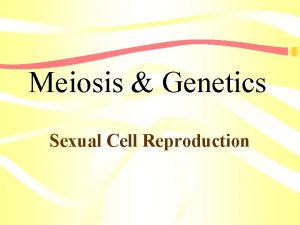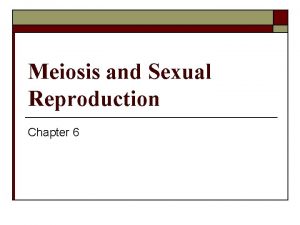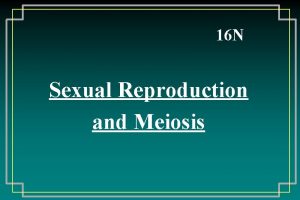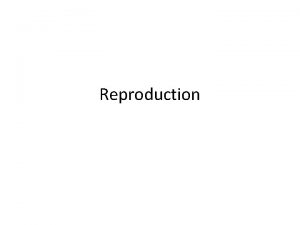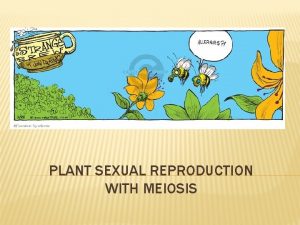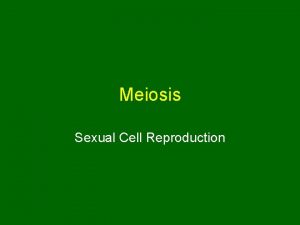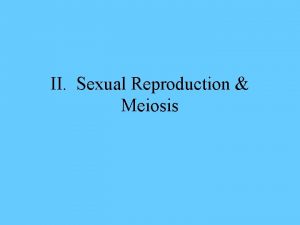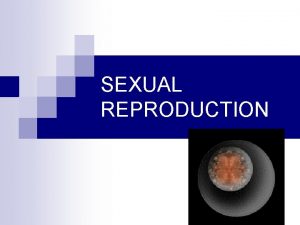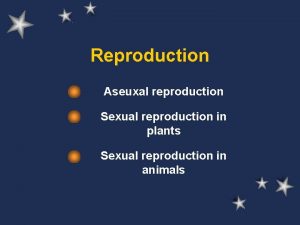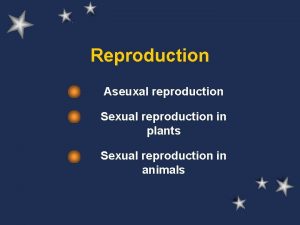Meiosis Sexual Reproduction Meiosis Sexual Reproduction and Genetics



























- Slides: 27

Meiosis Sexual Reproduction

Meiosis

Sexual Reproduction and Genetics Meiosis Chromosomes and Chromosome Number § Human body cells have 46 chromosomes § Each parent contributes 23 chromosomes § Homologous chromosomes—one of two paired chromosomes, one from each parent

Sexual Reproduction and Genetics Meiosis Homologous Chromosomes § Same length § Same centromere position § Carry genes that control the same inherited traits

Sexual Reproduction and Genetics Meiosis Gametes § Gametes are sex cells § Female gametes § Animals & Plants= eggs § Male gametes § Animals= sperm § Plants= pollen

Sexual Reproduction and Genetics Meiosis Haploid and Diploid Cells § An organism produces gametes to maintain the same number of chromosomes from generation to generation. § Human gametes contain 23 chromosomes. § A cell with n chromosomes is called a haploid cell. § A cell that contains 2 n chromosomes is called a diploid cell. § All human body cells have 46 chromosomes

Sexual Reproduction and Genetics Meiosis I § The sexual life cycle in animals involves meiosis. § Meiosis produces gametes (sex cells). § When gametes combine in fertilization, the number of chromosomes is restored.

Sexual Reproduction and Genetics Meiosis Stages of Meiosis I § Reduces the chromosome number by half through the separation of homologous chromosomes § Involves two consecutive cell divisions called meiosis I and meiosis II

Sexual Reproduction and Genetics Meiosis I § Interphase I § Chromosomes replicate. § Chromatin condenses. Interphase

Sexual Reproduction and Genetics Meiosis I § Prophase I § Pairing of homologous chromosomes occurs. § Each chromosome consists of two chromatids. § The nuclear envelope breaks down. § Spindle fibers form. Prophase I

Sexual Reproduction and Genetics Meiosis I § Prophase I § Each chromosome pairs with its corresponding homologous chromosome to form a tetrad § Tetrad § Contains 4 chromatids

Sexual Reproduction and Genetics Meiosis I § Prophase I § Crossing over produces exchange of genetic information. § Crossing over—chromosomal segments are exchanged between a pair of homologous chromosomes.

Sexual Reproduction and Genetics Meiosis I § Metaphase I § Chromosome centromeres attach to spindle fibers. Metaphase I § Homologous chromosomes line up at the equator.

Sexual Reproduction and Genetics Meiosis I § Anaphase I § Homologous chromosomes separate and move to opposite poles of the cell. Anaphase I

Sexual Reproduction and Genetics Meiosis I § Telophase I § The spindles break down. Telophase I § Chromosomes uncoil and form two nuclei. § The cell divides.

Sexual Reproduction and Genetics Meiosis II § Prophase II § A second set of Prophase II phases begins as the spindle apparatus forms and the chromosomes condense.

Sexual Reproduction and Genetics Meiosis II § Metaphase II § A haploid number of chromosomes line up at the equator. Metaphase II

Sexual Reproduction and Genetics Meiosis II § Anaphase II § The sister Anaphase II chromatids are pulled apart at the centromere by spindle fibers and move toward the opposite poles of the cell.

Sexual Reproduction and Genetics Meiosis II § Telophase II § The chromosomes Telophase II reach the poles, and the nuclear membrane and nuclei reform.

Sexual Reproduction and Genetics Meiosis II § Cytokinesis results in four haploid cells, each with n number of chromosomes. § http: //www. sumanasi nc. com/webcontent/a nimations/content/me iosis. html Cytokinesis


Meiosis

Sexual Reproduction and Genetics Meiosis The Importance of Meiosis § Meiosis consists of two sets of divisions § Produces four haploid daughter cells that are not identical § Results in genetic variation

Sexual Reproduction and Genetics Meiosis Provides Variation § Depending on how the chromosomes line up at the equator, four gametes with four different combinations of chromosomes can result. § Genetic variation also is produced during crossing over and during fertilization, when gametes randomly combine.

Sexual Reproduction and Genetics Meiosis Sexual Reproduction v. Asexual Reproduction § Asexual reproduction = Mitosis § The organism inherits all of its chromosomes from a single parent. § The new individual is genetically identical to its parent. § Sexual reproduction = Meiosis § Beneficial genes multiply faster over time. § Genetic Variation

Meiosis Square Dance

Difference between Mitosis vs. Meiosis
 Sexual reproduction and genetics section 1 meiosis
Sexual reproduction and genetics section 1 meiosis Sexual reproduction and genetics section 1 meiosis
Sexual reproduction and genetics section 1 meiosis Mendelian genetics
Mendelian genetics Chapter 10 sexual reproduction and genetics
Chapter 10 sexual reproduction and genetics Hare lynx
Hare lynx Binary fission in bacteria
Binary fission in bacteria Asexual vs sexual reproduction venn diagram
Asexual vs sexual reproduction venn diagram Two types of reproduction
Two types of reproduction Chromosomes in organisms
Chromosomes in organisms Asexual vs sexual reproduction venn diagram
Asexual vs sexual reproduction venn diagram Mitosis sexual reproduction
Mitosis sexual reproduction Example of sexual reproduction
Example of sexual reproduction Where does cactus store water
Where does cactus store water Parthenogenesis
Parthenogenesis Organisms that reproduce asexually
Organisms that reproduce asexually Metaphase ii
Metaphase ii Chapter 13 meiosis and sexual life cycles
Chapter 13 meiosis and sexual life cycles Reproduction in humans
Reproduction in humans Chapter 20 sexual reproduction in animals packet answers
Chapter 20 sexual reproduction in animals packet answers Define reproduction
Define reproduction Define sexual reproduction
Define sexual reproduction Whats asexual reproduction
Whats asexual reproduction Reproduction human
Reproduction human Sexual or asexual reproduction
Sexual or asexual reproduction Connecting the concepts sexual reproduction
Connecting the concepts sexual reproduction Biology
Biology Whats asexual reproduction
Whats asexual reproduction Disadvantages of sexual reproduction
Disadvantages of sexual reproduction












